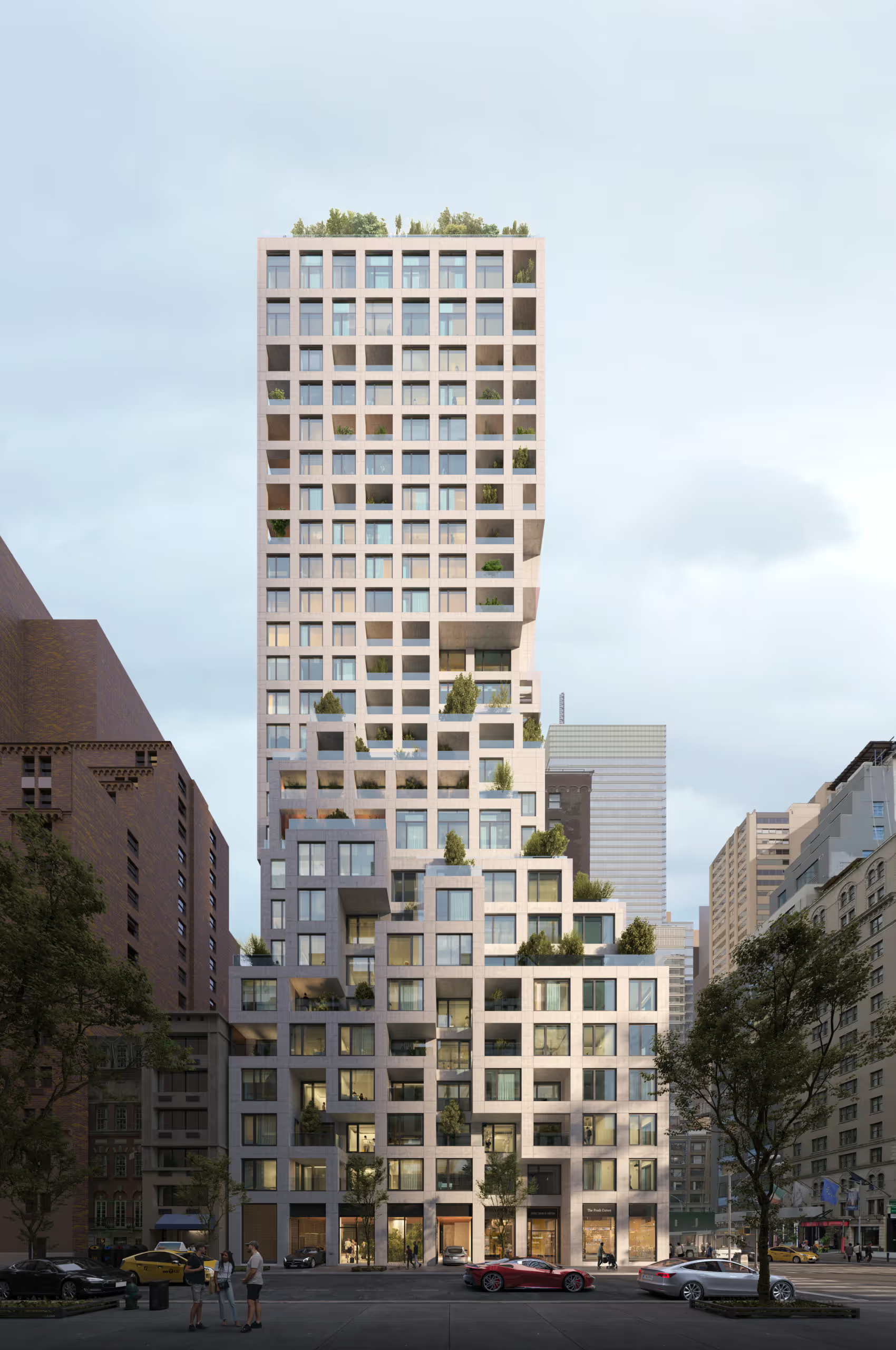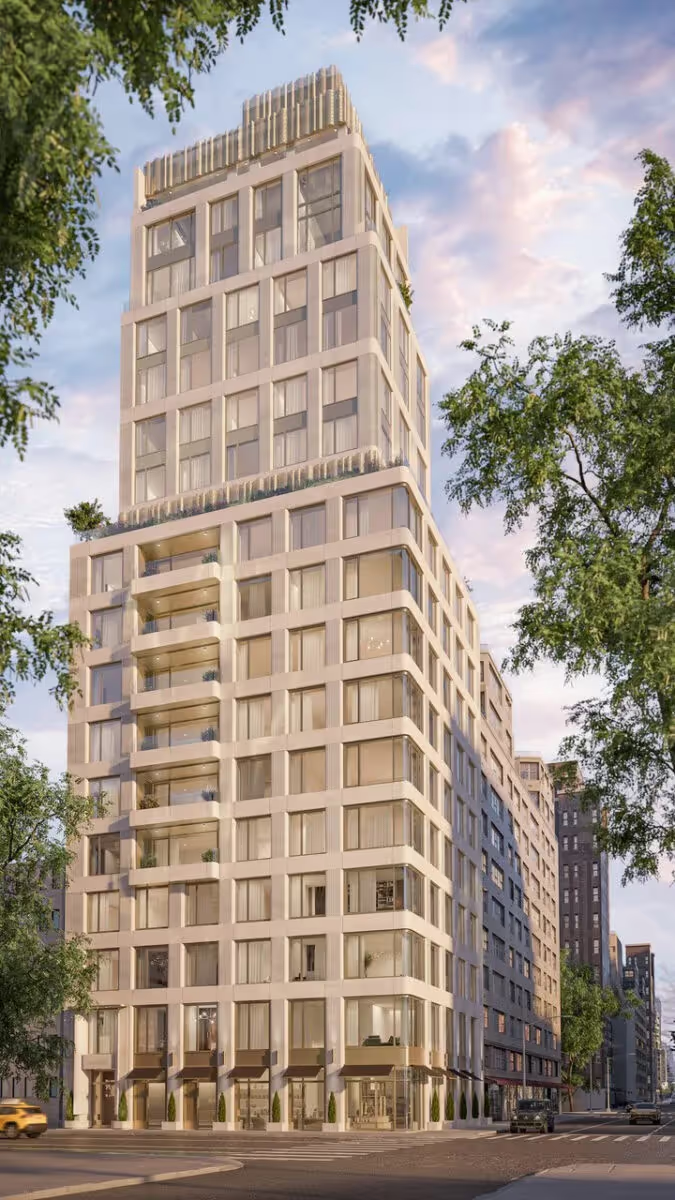


Photo Credit: YIMBY


Photo Credit: YIMBY


Photo Credit: YIMBY

They won’t top out until the end of the decade, but iconic new Manhattan office towers are finally going vertical.
And no wonder: Asking rents for beautiful, technologically advanced office space in prime locations are soaring toward $200 per foot.
Meanwhile, the success of JPMorgan Chase’s glamorous new headquarters at 270 Park Ave. is serving as proof of concept for ambitious new skyline stunners.
“It is creating a buzz about how transformative new construction is to the city,” said David Goldstein of Savills. “The new construction pipeline is definitely taking shape and the first out of the ground will have pricing and timing advantage.”
One of the earliest will be BXP’s 343 Madison Ave., designed by KPF, with 937,000 square feet. It has a letter of intent with C.V. Starr for a third of the 46-story tower, which won’t be delivered until 2029.
Not to be outdone, Scott Rechler’s RXR and TF Cornerstone are talking to anchor office tenants for their jumbo 2.9 million-square-foot tower at 175 Park Ave. Designed by Skidmore, Owings & Merrill, it would rise 1,575 feet above Grand Central Terminal and include a Hyatt hotel and transit improvements.
Vornado and Rudin are also in the game. They just got city approval to build a new 1.7 million-square-foot tower at 350 Park Ave. — with Citadel as partner and a 850,000-square-foot anchor space.
And Silverstein Properties is closing in on a deal with American Express to move from Brookfield Place to a new 2 World Trade Center, now likely to be around 2 million square feet.
In a move from Rockefeller Center, Deloitte has agreed to lease 700,000 square feet of Related’s 1.1 million-square-foot 70 Hudson Yards that is now under construction.
Nearby, BXP and Joseph Moinian are inching closer to getting 3 Hudson Blvd. out of the ground.
The reset in asking rents is also drawing investors into the market, spurring a slew of sales.
“Investors are back on the hunt for offices that were labeled as `kryptonite’ for a fair while.”
- David Goldstein of Savills
One Vanderbilt’s developer, SL Green, swooped in to pay $136 million for the 800,000-square-foot development site at 346 Madison, where buildings will need to be demolished to kick off construction.
It’s a bargain compared to the entirely vacant 405-417 Park Ave. blockfront between East 54th and 55th streets being marketed by Newmark — with pricing around $500 million — for a potential tower of 700,000 square feet.
Bob Knakal of BKREA is marketing dozens of land sites in Manhattan as well as 17 air rights transfers.
While many of those sites will become condos, some may become offices.
Although 30 million square feet worth of new towers were built over the last decade, it’s nearly all leased up. Jonathan Mazur of Newmark predicts 10 million square feet will rise by 2032 to meet demand — followed by more during that decade.
Some developers are seeking buildings with good bones that can be rehabbed faster than ground-up construction.
“Investors are back on the hunt for offices that were labeled as `kryptonite’ for a fair while,” Goldstein said.
A lease for the entire Chrysler Building is still up for grabs through Savills for landowner Cooper Union. SL Green would like to take charge of that partially vacant iconic Art Deco tower, but other operators are also in the mix.
Marketed by Eastdil, the $1.08 billion transfer of the IBM Building at 590 Madison Ave. to RXR at the end of the summer provided a boost to the tower sales market. Meanwhile, Norges Bank Investment Management pulled its cash from the ground up 343 Madison Ave. and pivoted to buy 1177 Sixth Ave. with Beacon for $572.29 million. It was marketed by Eastdil for Silverstein Properties and CalSTRS (which paid $1 billion in 2007). The largest tenant is the global law firm HFS Kramer.
“Those sales demonstrated there is institutional demand for New York City offices and reshaped the way people were thinking in a constructive and positive way,” said Will Silverman of Eastdil. “It was an institutional blessing.”
The new pricing also means that lenders, who took control of many assets during the nadir of the pandemic, are finally ready to sell. Other investors are selling to pay down existing debt, or to beef up cash reserves to redeploy into new projects.
For instance, Tishman Speyer is selling the lower 22 stories of CitySpire at 150 W. 56th St. with 370,000 square feet of offices.
“We are through the bottom and pricing is increasing but it is still down 30% to 40% from the peak,” said Andrew Scandalios of JLL.
Driven by a debt of $262.5 million, Rockwood and lender MetLife are trying to sell 2 Grand Central at 140 E. 45th St. They’re looking for north of $270 million with brokerage Eastdil — a discount from the $401 million paid in 2011.
“Sales demonstrated there is institutional demand for New York City offices and reshaped the way people were thinking in a constructive and positive way.”
- Will Silverman of Eastdil
The debt on the vacant 137,000-square-foot 90 Fifth Ave. is also for sale through Newmark.
Debt is one reason Charles Cohen sold the 382,500-square-foot office tower at 623 Fifth Ave. to Vornado for $218 million. It’s 75% vacant and Vornado will pour millions into the building to capture tenants who want to move in 2027.
BKREA and Rudder Property Group are selling the fully furnished former Core Club condo at 65 E. 55th St. for RFR for $40 million.
Across the street, Park Avenue Tower at 65 E. 55th St., marketed by Eastdil for Blackstone, is being sold to SL Green for $730 million.
RFR sold the vacant offices at 522 Fifth Ave. to Amazon earlier this year for $340 million plus another $85 million for its retail space.
“It’s a strong example of the lack of supply of big-block space,” RFR’s Gaby Rosen said. “They wanted to move from older, under amenitized properties.”




.avif)
Zoning plan opened floodgates for landmark buildings, brokers say
Before City of Yes, Bob Knakal would rarely work on air rights deals. When he did, it was one at a time. Now the chairman and CEO of BK Real Estate Advisors has 17 in the works.
Mayor Adams’ marquee rezoning plan, passed in December, has made these types of deals much easier, thanks to new flexibility around air rights, also called transferable development rights.
Commercial brokers say developers are seizing the opportunity — not just in the low-slung outer borough neighborhoods that were the focus of City of Yes, but in the priciest and densest parts of Manhattan.
“We have seen a definite uptick in clients interested in these transactions,” said James Power, an attorney and head of land use at Herbert Smith Freehills Kramer. What once had been a rare inquiry has become a regular conversation.
Landmarked buildings have been able to sell leftover development rights to adjacent lots since the 1960s. These buildings can’t be demolished, and most of them aren’t going to be built higher. Selling the floor area rights they’re entitled to through zoning can help those owners raise cash for repairs and maintenance.
But in the past half century, only 15 such deals have closed, according to the Department of Planning. Landmarked buildings could only transfer their rights to adjacent lots, which meant few potential buyers. Any deal also required a lengthy process to get approval from the city.
The City of Yes plan significantly expanded which lots could receive the rights. Landmarked buildings can now transfer development rights to lots on the same block, across the street or at the next intersection.
“You’re much more likely to transact if you have 52 potential buyers than if you have two,” Knakal said.
For brokers and lawyers, interest in air rights deals has swelled. Most of the deals brokers anticipate are in Manhattan, which has a high concentration of landmarked buildings. There are 1220 landmarked buildings and sites in the borough, according to the Landmarks Preservation Commission, compared to just 294 in Brooklyn with the second-highest concentration. Air rights typically sell for about half of what the land is worth, Knakal said, meaning that in areas where land values are lower, owners may not feel it worth the trouble to sell.
The City of Yes plan loosened zoning regulations in other ways, such as raising height limits in some parts of the city. Those changes have also encouraged owners to seek out air rights deals, Power said, because they are now permitted to build higher.
Part of the motivation behind the policy changes was to help owners of landmark buildings raise money to maintain them.
“Those landmarks can’t do anything with those air rights,” said Wilson Parry, CEO and co-founder at Property Scout. “It’s like found money for them.”
Another goal of making air rights transfers easier was to encourage housing density and development, as the mayor aims to build a moonshot 500,000 new units by 2032. The City of Yes plan overall is expected to create about 82,000 of those.
Brokers and lawyers said many deals are in the works, but none have closed. It may take some time for developers to seize upon the new rules and for the owners of landmarked buildings to learn about their new opportunities.
“A lot of times you don’t need the development rights until you’re in the process of building,” said Michael Smith, an attorney and partner at Herrick Feinstein. “You may be having conversations, you may be entering into contracts, but it hasn’t hit city records.”
The presence of retail leases and residential tenants can also hold up development, which in turn kicks air rights deals down the timeline. And there are still limitations on what you can build; receiving sites can only increase their density by 20 percent.
“The owners of landmarked buildings are anxious to sell and the developers are anxious to buy,” Power said. “It’s a matter of finding the right deal, the right time and the right business terms.”
Still, the process is much more streamlined than it once was. Although the city still needs to approve any transfers, there is no longer a need for a special permit and a lengthy process with the Landmarks Preservation Commission. Removing some of that uncertainty from the process has made it more attractive for both sides.
“Theoretically, City of Yes has definitely taken a good step forward for landmarks,” said Brian Strout, president and broker at TRIZ Advisory. ”Now it’s rolling up your sleeves to work through some of the practical realities.”




For all inquiries, reach out to your BKREA team member: